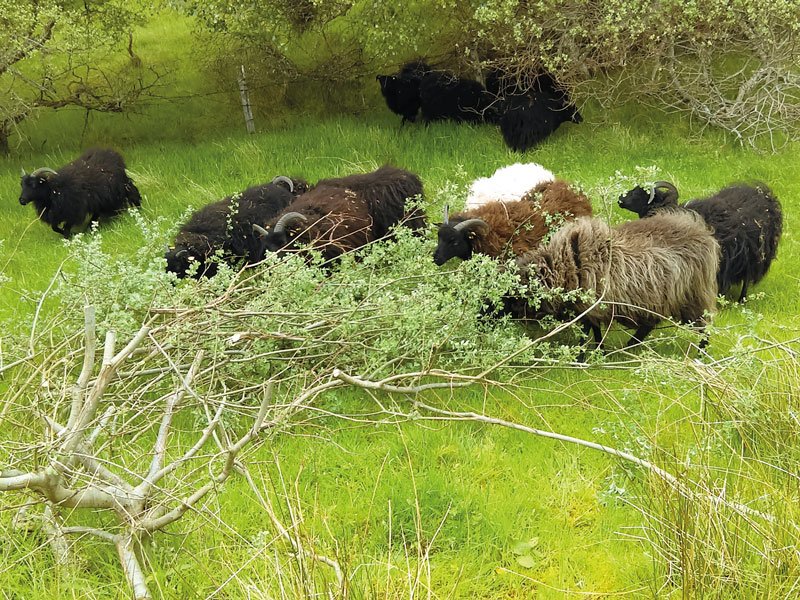First published in the Kyle Chronicle, Winter 2020/2021 edition
Farmers who use regenerative agriculture techniques accept that wildlife will share some of our harvest with us

UK farming has been in the news a lot lately. The combination of Brexit, Covid-19 and climate change has made many people rethink their food choices and sources. During the ongoing pandemic, sourcing our food locally and feeding our communities has become not just a necessity for many of us, but a passion. All around the UK, farmers, retail food outlets, and activists are joining forces to serve their communities. In the Highlands, efforts like Moo Foods, Planet Sutherland, Transition Black Isle, and more, are leading the way to sustainable practices and food growing/delivery. One phrase keeps appearing in many of the conversations with these groups and fellow farmers, in the Highlands and around the world: regenerative agriculture.
While headlines and politicians scream various predictions about how many years we have left before the earth’s soil will be degraded beyond the point of sustaining life, those engaged in regenerative agriculture are working to pull us back from the brink, however near or far that brink may really be.
According to Regeneration International, regenerative agriculture “describes farming and grazing practices that (…) reverse climate change by rebuilding soil organic matter and restoring degraded soil biodiversity – resulting in both carbon drawdown and improving the water cycle.”
Farmers who use regenerative techniques eschew the use of synthetic fertilizers, herbicides, and pesticides, in favour of encouraging ‘good’ bugs, organic fertilizers (straight from the grazers), mob grazing (hard grazing for short amounts of time), or the less intensive rotational grazing (a lower stocking density for longer periods), rotational and companion cropping, and a general acceptance that wildlife –whether bug, bird, or four legged– will share some of our harvest with us. We make sure the soil is covered with greenery all year round to avoid soil run-off and nutrient depletion, and we choose this year’s grass mix for what it will do for next year’s vegetable harvest. In return, we watch as poor soils turn rich again, birds return to nest, and our plant and animal crops help each other thrive.
Regenerative practices will look different on every farm –the field margins built into some farm systems wouldn’t fit onto our wee bit of land, for instance, and we can’t let our animals roam freely, like some large estates can– but we all share some basic practices, as highlighted in Farmers Weekly:
- Minimising soil disturbance
- Keeping the soil covered
- Maximising plant or crop diversity
- Integrating livestock

Choosing crops
When we took over the management of the farm five years ago, it hadn’t been a working farm for more than 30 years. In working to bring the farm back into production we inadvertently discovered this concept of regenerative agriculture. It started with our choice of sheep.
Hebrideans are native to Scotland, built to survive in its challenging environment. They thrive on forage other breeds won’t or can’t eat. They’re flowing grazers, spreading their fertilizing manure far and wide. Their way of living helps the land thrive: clearing saplings gives the stronger trees room to grow, pawing up the mosses and chewing off the tops of the reeds, to let the grass come through. They’re thinning the bracken, nettles and gorse, giving the birds room to nest. But thanks to their grazing methods, they seldom overgraze an area. Hebrideans and this land are perfectly suited to each other… and that’s the key to regenerative farming: choosing the crops, grass mixes, fruit and veg, and livestock that not only thrive on this farm but help each other do so, as well. It’s a trial and error technique, sometimes, but well worth the long term benefits.

Choosing Hebrideans triggered the rest: the first year we had to fertilize a field, we discovered ‘green manure’, crops you plant with the express intention of ploughing them back in to enrich the soil, instead of bringing in fertilizers; a lack of manpower forced me to let the tall grasses around the vegetable patch grow tall this year… and I saw them flower for the first time. My garden looks messy, but it’s full of life. And yes, it’s more work keeping the birds and bugs off the veg, than it would be if I used pesticides but I don’t mind the extra time spent working in the luscious black crumbly soil the old dirt is becoming. Because this way of farming is regenerative to us as well, because we know we’re building something that will only get better with time.
